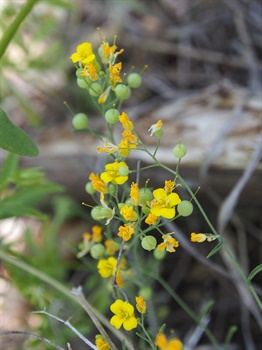Led by ANHC botanists Brent Baker and Diana Soteropoulos, researchers from the Missouri Botanical Garden recently visited all known Arkansas sites of Missouri bladderpod (Physaria filiformis), a listed threatened plant under the federal Endangered Species Act. The Missouri researchers, Dr. Matthew Albrecht and Dr. Christy Edwards, made field observations and collected flowering and fruiting specimens for a study funded by the U.S. Fish and Wildlife Service. The study will help determine if the plants in the Ouachita Mountains are morphologically distinct enough from those in the Ozark Highlands to be described as a new species. A previous genetic study indicated the Ouachita plants may be genetically distinct.
While in the field, Baker and Soteropoulos also monitored the Arkansas populations of Missouri bladderpod, as part of the annual grant the ANHC receives from the U.S. Fish and Wildlife Service. The grant is funded from the Cooperative Endangered Species Conservation Fund established under Section 6 of the Endangered Species Act. Funding is provided to states “to support the development and implementation of conservation programs for the benefit of resident listed, candidate, and at-risk species.”
 Named for its bladder-like seedpods, Missouri bladderpod is a short (about 8 inches high) annual plant with yellow flowers that bloom in the spring. It survives hot Arkansas summers as seeds that wait for the cooler temperatures of fall to germinate. The plant then spends winter as a small cluster of leaves. In spring, stems and flowers develop, seeds are produced and shed, and the life cycle starts over again. [Photo at left -- Missouri bladderpod (Physaria filiformis), a listed threatened plant under the federal Endangered Species Act, photo by Brent Baker.]
Named for its bladder-like seedpods, Missouri bladderpod is a short (about 8 inches high) annual plant with yellow flowers that bloom in the spring. It survives hot Arkansas summers as seeds that wait for the cooler temperatures of fall to germinate. The plant then spends winter as a small cluster of leaves. In spring, stems and flowers develop, seeds are produced and shed, and the life cycle starts over again. [Photo at left -- Missouri bladderpod (Physaria filiformis), a listed threatened plant under the federal Endangered Species Act, photo by Brent Baker.]
Missouri bladderpod is found in glades in Arkansas and Missouri. Glades typically are very dry (in the summer and fall; some are seasonally wet in winter and spring), open areas of land with thin soils where the underlying bedrock is often exposed or just below the surface. In Arkansas, there are nine different types of glades, depending on the underlying bedrock or soil: limestone, dolomite, sandstone, shale, novaculite, igneous (specifically nepheline syenite), chert, chalk, and saline (riverscour glades are also sometimes considered a type but can occur on various substrates). In Missouri and northwestern Arkansas, Missouri bladderpod is known from limestone glades. In north-central Arkansas, it is known from similar dolomite glades (limestone and dolomite are both calcareous). However, in the Ouachita Mountains, Missouri bladderpod is known from shale glades.
Protection and management of glades supporting populations of Missouri bladderpod is essential for the recovery of this species. Restoration of degraded glade habitats also plays an important role in its long-term survival, as well as other plants and animals dependent upon glades.
While in the field, Baker and Soteropoulos also monitored the Arkansas populations of Missouri bladderpod, as part of the annual grant the ANHC receives from the U.S. Fish and Wildlife Service. The grant is funded from the Cooperative Endangered Species Conservation Fund established under Section 6 of the Endangered Species Act. Funding is provided to states “to support the development and implementation of conservation programs for the benefit of resident listed, candidate, and at-risk species.”
 Named for its bladder-like seedpods, Missouri bladderpod is a short (about 8 inches high) annual plant with yellow flowers that bloom in the spring. It survives hot Arkansas summers as seeds that wait for the cooler temperatures of fall to germinate. The plant then spends winter as a small cluster of leaves. In spring, stems and flowers develop, seeds are produced and shed, and the life cycle starts over again. [Photo at left -- Missouri bladderpod (Physaria filiformis), a listed threatened plant under the federal Endangered Species Act, photo by Brent Baker.]
Named for its bladder-like seedpods, Missouri bladderpod is a short (about 8 inches high) annual plant with yellow flowers that bloom in the spring. It survives hot Arkansas summers as seeds that wait for the cooler temperatures of fall to germinate. The plant then spends winter as a small cluster of leaves. In spring, stems and flowers develop, seeds are produced and shed, and the life cycle starts over again. [Photo at left -- Missouri bladderpod (Physaria filiformis), a listed threatened plant under the federal Endangered Species Act, photo by Brent Baker.]Missouri bladderpod is found in glades in Arkansas and Missouri. Glades typically are very dry (in the summer and fall; some are seasonally wet in winter and spring), open areas of land with thin soils where the underlying bedrock is often exposed or just below the surface. In Arkansas, there are nine different types of glades, depending on the underlying bedrock or soil: limestone, dolomite, sandstone, shale, novaculite, igneous (specifically nepheline syenite), chert, chalk, and saline (riverscour glades are also sometimes considered a type but can occur on various substrates). In Missouri and northwestern Arkansas, Missouri bladderpod is known from limestone glades. In north-central Arkansas, it is known from similar dolomite glades (limestone and dolomite are both calcareous). However, in the Ouachita Mountains, Missouri bladderpod is known from shale glades.
Protection and management of glades supporting populations of Missouri bladderpod is essential for the recovery of this species. Restoration of degraded glade habitats also plays an important role in its long-term survival, as well as other plants and animals dependent upon glades.
